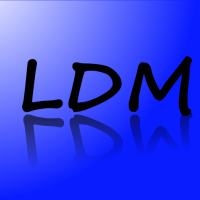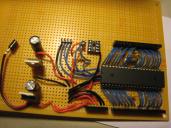Prop proto-board design
 lardom
Posts: 1,659
lardom
Posts: 1,659
in Propeller 1
This is my first try at making a Propeller pcb on proto-board. It wasn't as hard as I thought it would be. I needed an easier way to test my prototypes without having to plug it into a computer. I also wanted to be able to plug a pcb into headers like an Arduino shield does. I will shave about 3/4 of an inch off the length of the next one now that I have that initial experience.
Hopefully there are at least a few other hobbyists that will find this interesting.
Hopefully there are at least a few other hobbyists that will find this interesting.



Comments
You should really have a bypass cap on your EEPROM since you've located it far away from the CPU. The best board to use for soldering is double-sided matrix board that does not have any tracks at all. Then just solder wirewrap under the board to the pins rather than consuming all that room on top. The double-sided plated through holes are a lot more robust than a single sided and solder a lot better too.
btw, you can cheat and place caps and even the crystal inside the socket area under the chip itself.
Nothing will replace my Quickstart boards when I'm breadboarding at my computer. I just wanted an easier way to field test my projects. I also want to build pcb's with down-facing headers that I can plug directly into the Propeller board. I hope fellow hobbyists find that interesting so I'll post another photo when I get that done.
@Peter Jakacki, I will order a supply of 10uF tantalum caps and double sided matrix boards for my next version. Thanks for the tips.
Today you order from a online pcb proto service.
Looks like you can get it down to 2.6"x2.6" = 6.76 sqr inches.
$5*6.76 = $33 for three ($11 each) free shipping at oshpark.com
The one thing I'd change is the distance between the headers so I could plug another pcb into it. I want to eliminate that tangle of wires between prototyped pcb's.
BTW, Peter Jakacki is a great teacher. At that time he, as a professional engineer, guided me through the project until I had a working machine. I gained a ton of knowledge and I learned quickly because I had no guarantee that a professional engineer would decide that he no longer had time for a 'rookie' like me.
I still would like to help beginners because I benefited from other people helping me when I began.
As for wanting to help others that's better than all the thanks in the world. But you should do a write up of some kind on the forum about your project, we are always interested to see and hear about what others are doing with the Prop and how they got there.
You inspected my code and made several recommendations that I still apply today. The controller in the picture has AA batteries because you told me they would "last longer" than a 9 volt cell.
When I began I wondered if I was 'in over my head' but by the time my machine was finished I was pretty confident in my abilities. I even considered adding more features such as 'wear leveling' because I thought it might have commercial potential.
There is one project I'd like to share but I'm not happy with it and I don't expect to be done with it until summer. If there's any interest I'll share code and schematics.